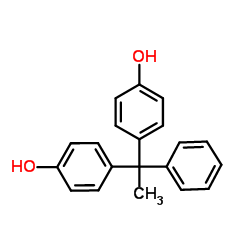Bisphenol AP

Bisphenol AP structure
|
Common Name | Bisphenol AP | ||
|---|---|---|---|---|
| CAS Number | 1571-75-1 | Molecular Weight | 290.356 | |
| Density | 1.2±0.1 g/cm3 | Boiling Point | 473.8±35.0 °C at 760 mmHg | |
| Molecular Formula | C20H18O2 | Melting Point | 188-191ºC | |
| MSDS | Chinese USA | Flash Point | 221.7±20.5 °C | |
| Symbol |

GHS07 |
Signal Word | Warning | |
|
Determination of bisphenols in beverages by mixed-mode solid-phase extraction and liquid chromatography coupled to tandem mass spectrometry.
J. Chromatogr. A. 1422 , 230-8, (2015) Facing growing restrictions on the use of bisphenol A in food contact materials, several bisphenol analogs are arising as major alternatives to replace this chemical in most of its applications. This work reports a simple and robust method based on mixed-mode... |
|
|
Derivatization of bisphenol A and its analogues with pyridine-3-sulfonyl chloride: multivariate optimization and fragmentation patterns by liquid chromatography/Orbitrap mass spectrometry.
Rapid Commun. Mass Spectrom. 29 , 1473-84, (2015) Due to the growing restrictions on the use of bisphenol A (BPA), several other bisphenols are gaining importance as substitutes for BPA in a variety of applications. There is, therefore, a real need for selective and sensitive methods based on mass spectromet... |
|
|
Bisphenol A and other bisphenol analogues including BPS and BPF in surface water samples from Japan, China, Korea and India.
Ecotoxicol. Environ. Saf. 122 , 565-72, (2015) Concentrations of eight bisphenol analogues (BPs) including BPA, BPS, and BPF were determined in surface waters collected from select rivers in Japan, Korea, China, and India. BPA was found at a concentration in the range of several tens to several hundreds o... |
|
|
A comparative assessment of human exposure to tetrabromobisphenol A and eight bisphenols including bisphenol A via indoor dust ingestion in twelve countries.
Environ. Int. 83 , 183-91, (2015) Tetrabromobisphenol A (TBBPA) and eight bisphenol analogues (BPs) including bisphenol A (BPA) were determined in 388 indoor (including homes and microenvironments) dust samples collected from 12 countries (China, Colombia, Greece, India, Japan, Kuwait, Pakist... |
|
|
Structure-based discovery of triphenylmethane derivatives as inhibitors of hepatitis C virus helicase.
J. Med. Chem. 52 , 2716-23, (2009) Hepatitis C virus nonstructural protein 3 (HCV NS3) helicase is believed to be essential for viral replication and has become an attractive target for the development of antiviral drugs. A fluorescence resonant energy transfer helicase assay was established f... |